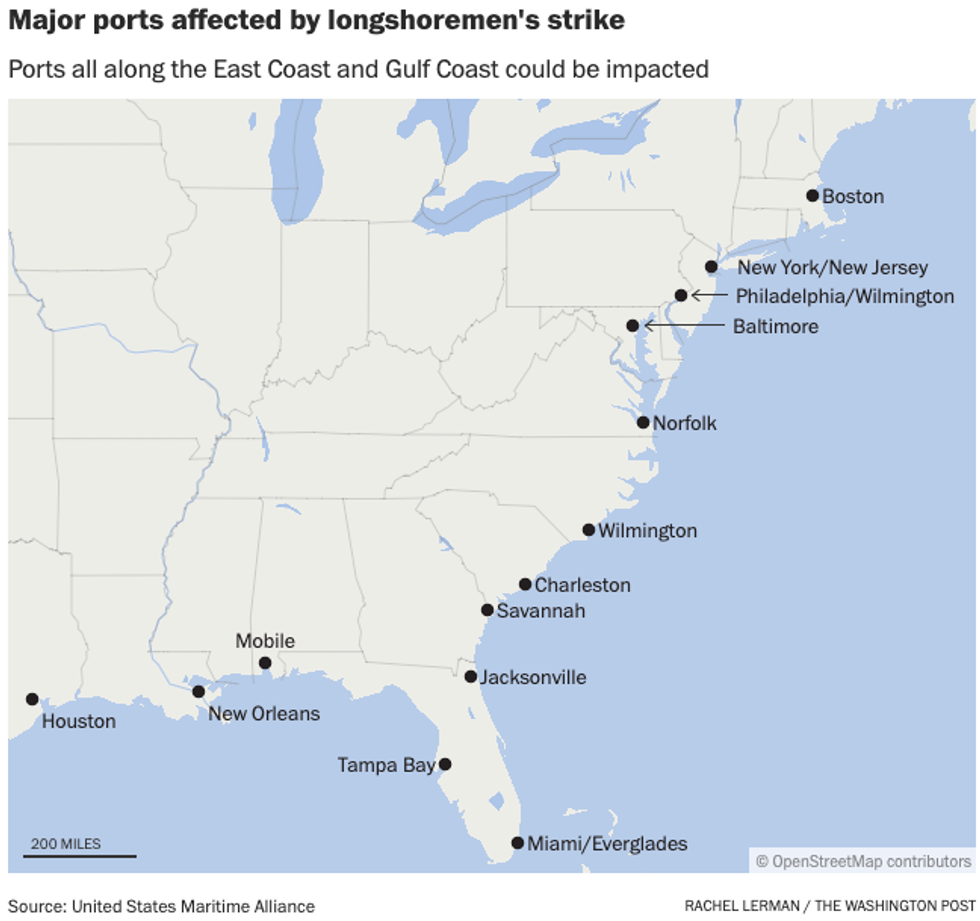
A photograph shows cranes and containers at the port of Norfolk, Virginia in 2023.
East and Gulf Coast Dockworkers Set to Strike After Rejecting 'Insulting' Wage Offers
The union called out "a half-century of wage subjugation" and said the wages the port operators were offering were "a joke."
Dockworkers at East and Gulf Coast ports are set to go on strike after their contract expires at midnight on Monday as they seek higher pay and better job protections, in what would be the first coordinated walkout at ports from Maine to Texas since 1977.
The International Longshoremen's Association (ILA), a union, has reached an impasse with the United States Maritime Alliance (USMX), the port operators' group, over pay rises and protection against automation of jobs, among other benefits.
The strike is expected to have consequences across the economy: East and Gulf Coast ports bring in about half of the country's containerized goods and send out about two-thirds of them.
President Joe Biden doesn't plan to intervene to force a deal, administration officials have said, following pressure from union officials and advocates who want to ensure the dockworkers keep their right to strike.
An ILA statement on Sunday said USMX "refuses to address a half-century of wage subjugation," and another earlier in the week referred to the wages the port operators were offering as "insulting" and "a joke."
The expiring contract covers 45,000 longshoremen at about three dozen ports, including the Port of New York and New Jersey, which is the third busiest in the country.
The last strike at all of the East and Gulf Coast ports was in 1977; containerized trade is now even more essential to the U.S. economy than it was then.
West Coast dockworkers are covered under a different contract that was reached last year after many months of acrimonious negotiations.
The U.S. president has the authority to suspend a dockworkers strike under the Taft-Hartley Act, anti-union legislation passed in 1947. Presidents Richard Nixon and George W. Bush both used the act to break dockworkers strikes.
Union officials are watching the Biden administration closely in the current labor dispute. AFL-CIO President Elizabeth Shuler last week implored Congress to stay out of the process, warning that even the suggestion of federal intervention could prevent USMX from negotiating in good faith.
"Averting a strike is the responsibility of the employers who refuse to offer ILA members a contract that reflects the dignity and value of their labor," Schuler wrote.
Biden, a Democrat, angered many union members and working class advocates in 2022 by working with Congress to intervene to stop a major railworkers strike.
Some experts believe the president won't want to do that again ahead of the November election, for fear of hurting Democratic turnout.
"They just don't want to have a fight with labor going into the election," Harry Katz, an economist and labor relations expert at Cornell University, told The New York Times. "Because you need the unions to get out the vote."
However, the administration will also likely face pressure from certain Democrats and business interests who worry about the economic impact of a strike just before the elections. JPMorgan analysts estimated that the strike would cost the U.S. economy about $5 billion per day, roughly 6% of gross domestic product.
"There is little chance that the administration would risk jeopardizing its recent economic successes less than two months before a tightly-contested election," Bradley Saunders, an economist at Capital Economics, wrote in a note to clients last week, according to The Washington Post.
The ILA and USMX are negotiating pay increases, healthcare benefits, and the use of automated or semi-automated terminals, which threaten jobs. Pay has reportedly emerged as a central point of contention in recent negotiations. USMX offered an hourly pay rise of $2.50 each year over the course of a six-year contract; the ILA asked for a $5 raise per year, the Times reported.
The current top pay rate for the 45,000 longshoremen is $39 an hour, but the West Coast dockworkers are set to receive just over $60 in 2027, the final year of their contract. The ILA's requested rate would mean the top rate was $69 an hour in the final year of the new contract.
USMX is made up of global shipping companies that made "windfall profits" in 2021 and 2022, according to the Times.
The shutdown, which could begin as early as 12:01 am on Tuesday, won't affect cruise ships or military cargo, which the ILA has pledged to continue transporting.
An Urgent Message From Our Co-Founder
Dear Common Dreams reader, The U.S. is on a fast track to authoritarianism like nothing I've ever seen. Meanwhile, corporate news outlets are utterly capitulating to Trump, twisting their coverage to avoid drawing his ire while lining up to stuff cash in his pockets. That's why I believe that Common Dreams is doing the best and most consequential reporting that we've ever done. Our small but mighty team is a progressive reporting powerhouse, covering the news every day that the corporate media never will. Our mission has always been simple: To inform. To inspire. And to ignite change for the common good. Now here's the key piece that I want all our readers to understand: None of this would be possible without your financial support. That's not just some fundraising cliche. It's the absolute and literal truth. We don't accept corporate advertising and never will. We don't have a paywall because we don't think people should be blocked from critical news based on their ability to pay. Everything we do is funded by the donations of readers like you. Will you donate now to help power the nonprofit, independent reporting of Common Dreams? Thank you for being a vital member of our community. Together, we can keep independent journalism alive when it’s needed most. - Craig Brown, Co-founder |
Dockworkers at East and Gulf Coast ports are set to go on strike after their contract expires at midnight on Monday as they seek higher pay and better job protections, in what would be the first coordinated walkout at ports from Maine to Texas since 1977.
The International Longshoremen's Association (ILA), a union, has reached an impasse with the United States Maritime Alliance (USMX), the port operators' group, over pay rises and protection against automation of jobs, among other benefits.
The strike is expected to have consequences across the economy: East and Gulf Coast ports bring in about half of the country's containerized goods and send out about two-thirds of them.
President Joe Biden doesn't plan to intervene to force a deal, administration officials have said, following pressure from union officials and advocates who want to ensure the dockworkers keep their right to strike.
An ILA statement on Sunday said USMX "refuses to address a half-century of wage subjugation," and another earlier in the week referred to the wages the port operators were offering as "insulting" and "a joke."
The expiring contract covers 45,000 longshoremen at about three dozen ports, including the Port of New York and New Jersey, which is the third busiest in the country.
The last strike at all of the East and Gulf Coast ports was in 1977; containerized trade is now even more essential to the U.S. economy than it was then.
West Coast dockworkers are covered under a different contract that was reached last year after many months of acrimonious negotiations.
The U.S. president has the authority to suspend a dockworkers strike under the Taft-Hartley Act, anti-union legislation passed in 1947. Presidents Richard Nixon and George W. Bush both used the act to break dockworkers strikes.
Union officials are watching the Biden administration closely in the current labor dispute. AFL-CIO President Elizabeth Shuler last week implored Congress to stay out of the process, warning that even the suggestion of federal intervention could prevent USMX from negotiating in good faith.
"Averting a strike is the responsibility of the employers who refuse to offer ILA members a contract that reflects the dignity and value of their labor," Schuler wrote.
Biden, a Democrat, angered many union members and working class advocates in 2022 by working with Congress to intervene to stop a major railworkers strike.
Some experts believe the president won't want to do that again ahead of the November election, for fear of hurting Democratic turnout.
"They just don't want to have a fight with labor going into the election," Harry Katz, an economist and labor relations expert at Cornell University, told The New York Times. "Because you need the unions to get out the vote."
However, the administration will also likely face pressure from certain Democrats and business interests who worry about the economic impact of a strike just before the elections. JPMorgan analysts estimated that the strike would cost the U.S. economy about $5 billion per day, roughly 6% of gross domestic product.
"There is little chance that the administration would risk jeopardizing its recent economic successes less than two months before a tightly-contested election," Bradley Saunders, an economist at Capital Economics, wrote in a note to clients last week, according to The Washington Post.
The ILA and USMX are negotiating pay increases, healthcare benefits, and the use of automated or semi-automated terminals, which threaten jobs. Pay has reportedly emerged as a central point of contention in recent negotiations. USMX offered an hourly pay rise of $2.50 each year over the course of a six-year contract; the ILA asked for a $5 raise per year, the Times reported.
The current top pay rate for the 45,000 longshoremen is $39 an hour, but the West Coast dockworkers are set to receive just over $60 in 2027, the final year of their contract. The ILA's requested rate would mean the top rate was $69 an hour in the final year of the new contract.
USMX is made up of global shipping companies that made "windfall profits" in 2021 and 2022, according to the Times.
The shutdown, which could begin as early as 12:01 am on Tuesday, won't affect cruise ships or military cargo, which the ILA has pledged to continue transporting.
Dockworkers at East and Gulf Coast ports are set to go on strike after their contract expires at midnight on Monday as they seek higher pay and better job protections, in what would be the first coordinated walkout at ports from Maine to Texas since 1977.
The International Longshoremen's Association (ILA), a union, has reached an impasse with the United States Maritime Alliance (USMX), the port operators' group, over pay rises and protection against automation of jobs, among other benefits.
The strike is expected to have consequences across the economy: East and Gulf Coast ports bring in about half of the country's containerized goods and send out about two-thirds of them.
President Joe Biden doesn't plan to intervene to force a deal, administration officials have said, following pressure from union officials and advocates who want to ensure the dockworkers keep their right to strike.
An ILA statement on Sunday said USMX "refuses to address a half-century of wage subjugation," and another earlier in the week referred to the wages the port operators were offering as "insulting" and "a joke."
The expiring contract covers 45,000 longshoremen at about three dozen ports, including the Port of New York and New Jersey, which is the third busiest in the country.
The last strike at all of the East and Gulf Coast ports was in 1977; containerized trade is now even more essential to the U.S. economy than it was then.
West Coast dockworkers are covered under a different contract that was reached last year after many months of acrimonious negotiations.
The U.S. president has the authority to suspend a dockworkers strike under the Taft-Hartley Act, anti-union legislation passed in 1947. Presidents Richard Nixon and George W. Bush both used the act to break dockworkers strikes.
Union officials are watching the Biden administration closely in the current labor dispute. AFL-CIO President Elizabeth Shuler last week implored Congress to stay out of the process, warning that even the suggestion of federal intervention could prevent USMX from negotiating in good faith.
"Averting a strike is the responsibility of the employers who refuse to offer ILA members a contract that reflects the dignity and value of their labor," Schuler wrote.
Biden, a Democrat, angered many union members and working class advocates in 2022 by working with Congress to intervene to stop a major railworkers strike.
Some experts believe the president won't want to do that again ahead of the November election, for fear of hurting Democratic turnout.
"They just don't want to have a fight with labor going into the election," Harry Katz, an economist and labor relations expert at Cornell University, told The New York Times. "Because you need the unions to get out the vote."
However, the administration will also likely face pressure from certain Democrats and business interests who worry about the economic impact of a strike just before the elections. JPMorgan analysts estimated that the strike would cost the U.S. economy about $5 billion per day, roughly 6% of gross domestic product.
"There is little chance that the administration would risk jeopardizing its recent economic successes less than two months before a tightly-contested election," Bradley Saunders, an economist at Capital Economics, wrote in a note to clients last week, according to The Washington Post.
The ILA and USMX are negotiating pay increases, healthcare benefits, and the use of automated or semi-automated terminals, which threaten jobs. Pay has reportedly emerged as a central point of contention in recent negotiations. USMX offered an hourly pay rise of $2.50 each year over the course of a six-year contract; the ILA asked for a $5 raise per year, the Times reported.
The current top pay rate for the 45,000 longshoremen is $39 an hour, but the West Coast dockworkers are set to receive just over $60 in 2027, the final year of their contract. The ILA's requested rate would mean the top rate was $69 an hour in the final year of the new contract.
USMX is made up of global shipping companies that made "windfall profits" in 2021 and 2022, according to the Times.
The shutdown, which could begin as early as 12:01 am on Tuesday, won't affect cruise ships or military cargo, which the ILA has pledged to continue transporting.


